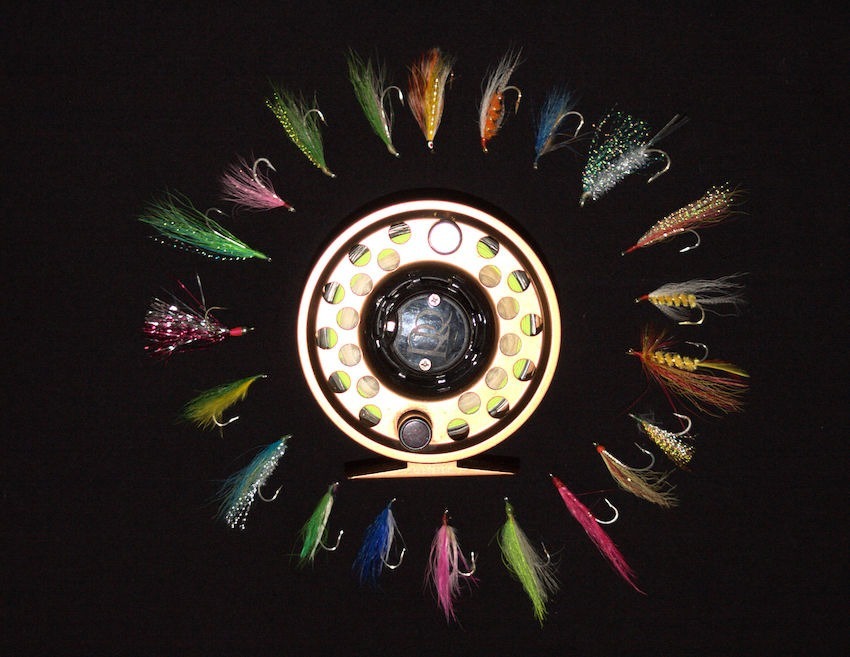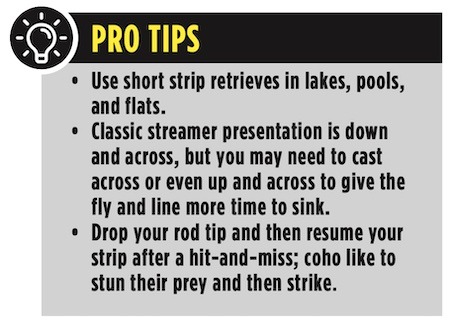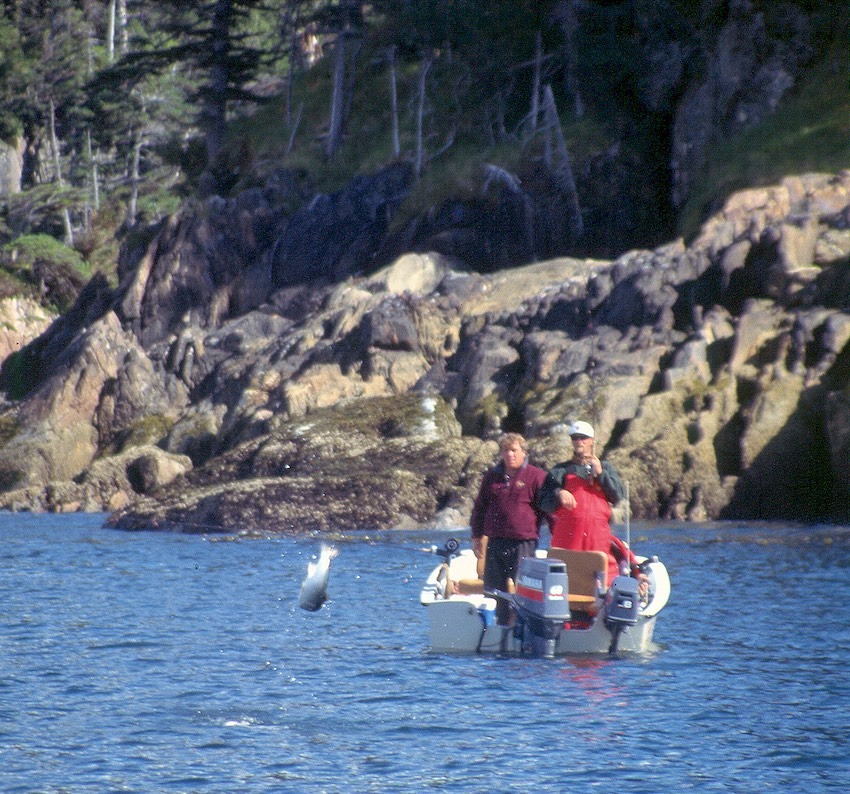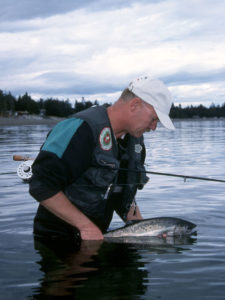Big fish are “meat and potato” feeders, and they like big meals. They don’t bother with tiny flies much, if at all—there is just not enough nourishment returned to them for their efforts. Anyone doing even a minimal amount of research will soon find that big fish of any species prefer to eat smaller fish. The Gerard rainbows of Kootenay Lake like to eat the kokanee, and sea-run cutthroats love to target salmon fry. Regardless of the species, fresh or saltwater, this rule remains consistent: To catch big fish, fly-fishers need to fish big flies that imitate small bait fish. Streamers and bucktails are designed to do that very thing.
Fly Action and Speed
Fly action and speed are the key ingredients to successful streamer fishing. The speed and depth of presentation depend upon the actual baitfish being imitated. Some, like the sculpin, move and dart from rock to rock near the bottom of rivers and can be effectively imitated with a Marabou Muddler fished with a jerking motion deep near the bottom. Other baitfish move swiftly in the main water column and must be imitated in the same way. In the ocean, escaping forage fish run and literally leap out of the water in their attempts to escape pursuing salmon. Regardless of the waters fished or the fish being fished for, your streamer should move as the natural baitfish does, which is most often a quick darting action. This makes the fly come alive and prevents the predator from getting a clear look at the feathers and hair.

Where To Fish Streamers
Lakes, river pools, and slow-moving flats are opportune places to employ streamers. Here, your primary focus should be on the depth of the water and how to get the fly down to where the fish are. This is usually done by employing a full sink, a leadcore leader, and/or using a weighted fly, or—if necessary—all three. If the water current is slow to moderate, I use a common method called the “countdown method” to judge the fly depth. I cast out and start counting the seconds as the fly and line sink. When I reach a certain count, the line has reached a certain depth. I can repeat that process knowing that my fly is getting to the same depth every cast. If I want to go deeper, I just count longer. If I pick up bottom I shorten my count next cast.
 Since the water in lakes, pools, and flats is not flowing, or only flowing slowly, you need to impart motion to your fly by actively retrieving it. Short strip retrieves are best here because they impart darting motion to the fly, cause the fly’s material to move and undulate in the water, and make it appear as though it is in a hurry to get away from whatever is trying to eat it. Naturally, not all forage fish move about in the same fashion, so you have to reproduce the movement of what your fly is meant to imitate as best you can. If you are pursuing coho in the ocean, you need to modify your retrieve to long, fast strips—as fast as you can retrieve. This seems strange to the novice, but experienced coho fishers will tell you that you cannot outstrip a coho. As a matter of fact, your fastest retrieve is a stroll in the park for one of those beautiful fish. As you can see, retrieve is not as simple as it may appear and it is a combination of the natural movement of whatever you are imitating and the preferences of the species of fish for which you are fishing.
Since the water in lakes, pools, and flats is not flowing, or only flowing slowly, you need to impart motion to your fly by actively retrieving it. Short strip retrieves are best here because they impart darting motion to the fly, cause the fly’s material to move and undulate in the water, and make it appear as though it is in a hurry to get away from whatever is trying to eat it. Naturally, not all forage fish move about in the same fashion, so you have to reproduce the movement of what your fly is meant to imitate as best you can. If you are pursuing coho in the ocean, you need to modify your retrieve to long, fast strips—as fast as you can retrieve. This seems strange to the novice, but experienced coho fishers will tell you that you cannot outstrip a coho. As a matter of fact, your fastest retrieve is a stroll in the park for one of those beautiful fish. As you can see, retrieve is not as simple as it may appear and it is a combination of the natural movement of whatever you are imitating and the preferences of the species of fish for which you are fishing.

In faster flowing water, it’s not necessary for you to impart much motion to the fly; the current does most of the work. Faster water does have its disadvantages, though: it causes drag and makes it difficult to get your fly down to the level of the fish.
Get Your Fly To Depth
Getting your fly to the depth of the fish can be simple or difficult, depending on the water depth and speed of the current. You can control the sink rate of your fly by using weighted flies, using various sink rate fly-lines, modifying the angle of your cast, and mending your line, or a combination of these things. The deeper and faster the flow, the faster the sink rate you will need to use. And while the classic streamer presentation is a down-and-across presentation, you may need to cast across or even up and across to give the fly and line more time to sink before it starts to drag through the downstream sweep.
Mending Your Line
All these points are designed to get the fly down to the depth of the fish, but mending your line serves a second, very important purpose: It helps present the fly to the fish in the correct orientation. Let me expand on this point, because it is important.

When fishing streamers in faster current, drag is actually a bit of a catch-22: You use it to impart motion to your fly, but you have to manage it so that the motion is applied at the right time in your drift. All fish naturally face into the current, and since streamers and bucktails are most often designed to imitate baitfish, it is important to present your fly facing into the current or darting across the current. Even broadside works, but downstream usually does not. If your fly is facing downstream as it passes by your quarry, you have far less of a chance of a strike. Predatory fish are used to seeing their food swimming away from them into the current or across the current, rarely downstream. Mending your fly-line with an upstream mend helps put the fly downstream of the leader and first length of line, and as the current pulls on the fly, it will orient your fly facing upstream or cross-current.
The Strike
As the line drifts downstream, the current will start to tighten it and the streamer will start moving across the current. This is most often when a strike will occur. Your fly darting cross-current in front of your quarry can stimulate a predatory response in the fish. The strike is usually aggressive and hard, so be ready. An active retrieve is usually not necessary, since the river’s current will do the work for you. Instead, focus on mending so that the fly is facing upstream as much as possible as it crosses the stream, and wait until the fly sweeps directly downstream of you before retrieving and casting again. Many anglers make the mistake of picking up and casting again before the fly has swung completely through its arc. Don’t do this. Fish the fly all the way through the sweep until it is directly downstream of you, then pick it up and re-cast.
And here is a little tip you can try that works really well, especially if you can position yourself to fish directly downstream: Notice that when your line is directly downstream from you, if you move your rod tip 90 degrees to the right or left, the current will sweep your line and fly over as far as your rod tip goes. You can fish like this with a streamer by starting with a short line and guiding your fly under overhangs and just above logjams, etc. If you throw in a mend, you can reach even further to the left or right. Sweep the fly back and forth, enticing any trout slightly downstream of it to bite. A little rod tip twitch now and then can help entice a fish to strike as well. If nothing takes the fly, then pull out a few more feet of line and repeat the process a little further downstream. There’s no need even to cast. A lot of big fish have been pulled out of their hiding holes using this technique.
Mimicking the Baitfish
The standard techniques I have described above work reliably, but your best teachers are the minnows and fry themselves. Watch minnows and sculpins in the water and see how they swim. This will tell you how to fish your streamers better than anything else. Imitate the various darting and even swimming rhythms of minnows by imparting combinations of hand strips and rod tip twitches. Erratic behaviour can entice fish to bite. And if you get a hit and miss, immediately allow your fly to tumble by dropping your rod tip and imparting some slack to your line. Attacking fish often stun their prey first and return to eat when it’s easier to grab. They will often seize it broadside like a dog with a bone and then swallow it head first; it’s easier to swallow with the fins facing the right way. Coho are notorious for stunning their prey first. If you drop your rod tip for a second and then resume your strip, they will often hammer the fly hard just when the fly starts to move again.
Another challenge occurs when the current is so swift that your fly actually sweeps across the current too fast. You deal with this situation by managing your line during the sweep. Earlier I mentioned that you don’t normally retrieve when the fly is sweeping cross-current. If the sweep is too fast, you simply allow line to slip through your fingers at a controlled rate so that the fly continues to sweep cross-current as it also slips downstream and so it crosses the current at a reduced rate. This will allow the fish time to see the fly and react to it before it goes flashing by in a blur.
While technique is key to fishing streamers and bucktails successfully, timing is also important. Big fish don’t like to expose themselves to predators. They stay in the dark depths under cover during the daylight hours, especially on sunny days, limiting their foraging times to dusk and night. Keep this in mind. Pursue the big fish when they feel more confident about feeding. Some of the biggest browns to come out of my area were caught in the dead of night. A little daytime exploration will help. Visit the areas you want to fish and learn where the holes and hiding places are; the snags, logs and branches that will cause you problems; and the best places to position yourself to fish these spots most effectively. Then you can return at dusk and get set up for dark when the lunkers come a-feedin’. Just make sure you don’t dangle your toes in the water after sunset.






